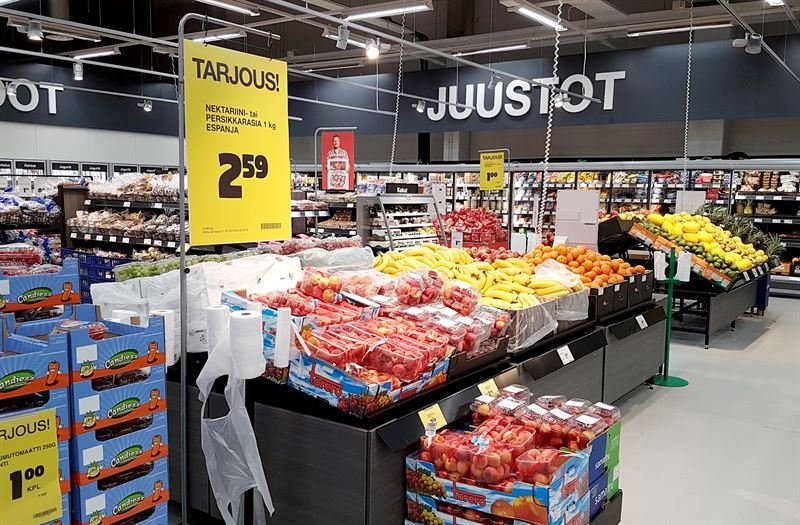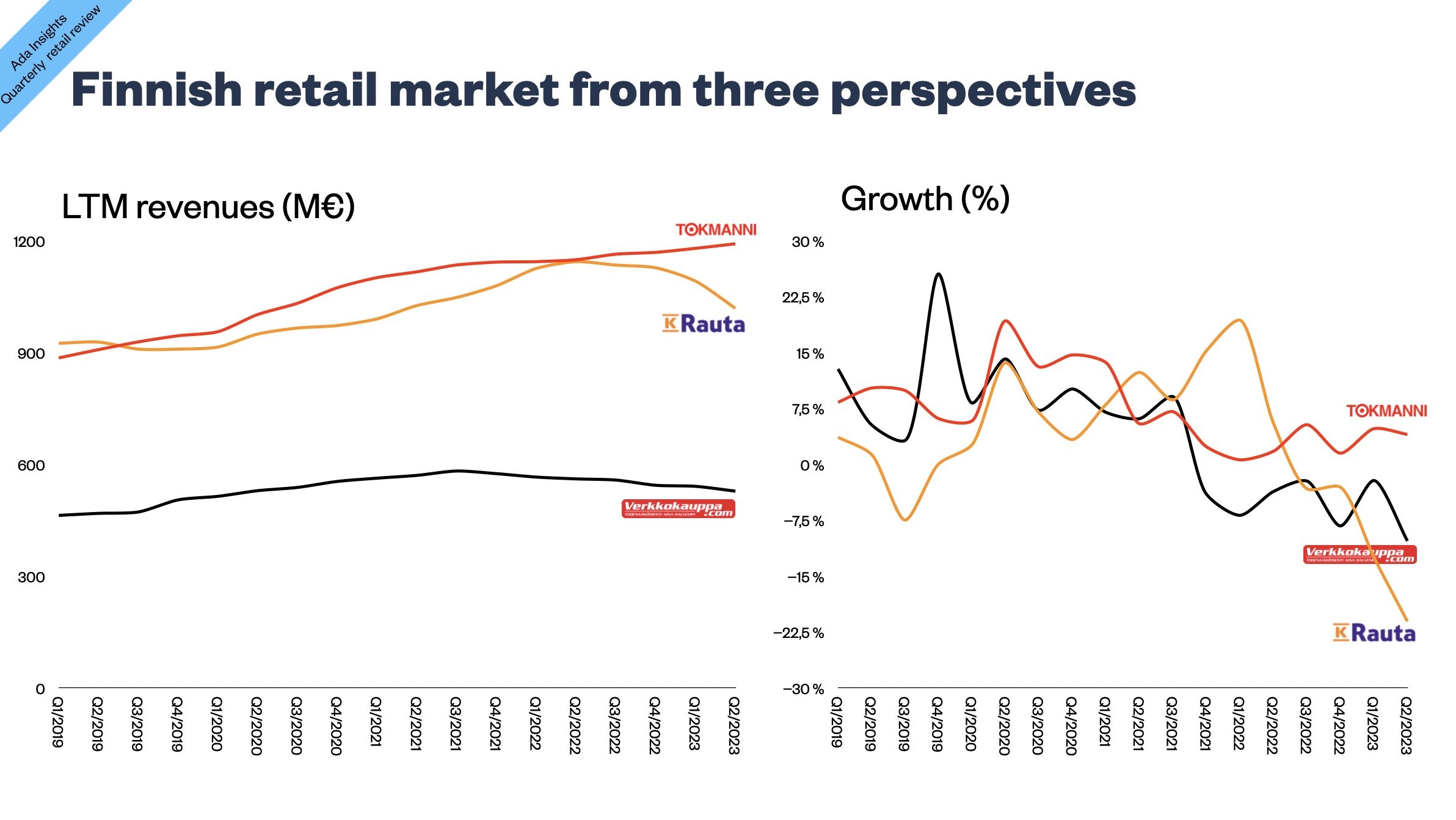Could Tokmanni become the Willy’s of Finland?
The soft grocery discounter Willy’s has become one of the biggest success stories in Nordic retailing, especially during the high inflationary times of 2022 and early 2023. Three consecutive 20+% growth quarters is an excellent performance for any retailer, let alone for a grocer. Lidl has succeeded in Sweden (like in Finland), but Willy’s has shown it can flourish alongside the German discounter.
Willy’s was the biggest growth story among Nordic grocery retailers last year.
The soft discounter model compromises between the traditional big assortment model of the hypermarkets and the hard discounters’ approach of small assortment and low-costs. Willy’s seems to be balancing that compromise very well.
The Finnish grocery market is starkly divided between the two opposites. The market does not have many alternatives between the traditional big assortment stores and high-volume but small assortment Lidl. Norway and Denmark seem to have more soft discount concepts than the other Nordic countries. They don’t seem to have hypermarkets at all.
The Finnish grocery market is also more heavily concentrated than in Sweden. The high concentration has led to the increased profitability of the existing players.
Where could competition arise?
Over the years, there has been speculation about whether new grocers could enter Finland. Some have hoped that Aldi would enter Finland, and others have expected an online player like Amazon or Oda.
Online pure player Oda was the first grocery retailer to enter Finland since Lidl’s launch in 2002.
Despite the high-profile launch and visible trucks in the streets, Oda will not significantly impact the overall market in the near future. Online remains a niche channel for the coming years. Oda (and other online players in the future) will probably operate only in the big cities, thus limiting the potential to influence the overall market.
Image source: Oda
It is also unlikely that a company like Aldi, which does not have operations in any neighbouring market, would suddenly launch operations in Finland. Finland is logistically too isolated.
But there is the famous quote by Jeff Bezos that ”Your margin is my opportunity”. We do lack competition in Finland, especially in the soft discount segment.
Soft discounters to the rescue?
Thus, the only options for the increasing competition are
a) Willy’s coming from the neighbouring Sweden (Axfood/Willy’s is the only likely Swedish grocer to enter) or
b) Tokmanni investing in groceries to build a national presence.
The more likely option of the two is that Tokmanni, with hundreds of stores and a supply chain in place, would expand its grocery operation to include complete grocery offerings in more than the current 18 full-line grocery stores.
There are many similarities between Willy’s stores and what Tokmanni’s stores look like. Tokmanni already feels and looks like a soft discounter.
Why would groceries make sense for Tokmanni?
Grocery would make a lot of sense for Tokmanni. The company is already Finland’s fourth biggest grocery retailer with a minuscule 3,3% market share. Despite the small market, groceries represent 56% of Tokmanni’s revenue.
Image source: Tokmanni
Becoming a significant grocery player with hundreds of stores (Willy’s has 236 stores) requires a lot of costly logistics investments and possibly new stores. Tokmanni currently has 198 stores but only 18 full-line grocery stores (selling also fresh and frozen products). On the other hand, groceries provide vast revenues (grocery is 40% of all retailing in Finland) and high shopping frequencies.
Where a traditional non-food customer buys products monthly, a grocery customer purchases food many times a week. These buying occasions provide big possibilities to sell higher margin non-food products. The increased shopping frequency in Tokmanni would also improve customer loyalty and thus reinforce Tokmanni’s status as a place to buy any product customers would need.
Additionally, groceries could make Tokmanni a more attractive place for the most significant customer segment, families with children. The general impression of Tokmanni is that they cater more for older customer segments and probably more in the country’s less urban areas. Maybe groceries could allow them to expand their presence for urban families with children.
It is wrong to say that the grocery market in Finland does not have competition. The competition is just focused on two rather similar huge grocers.
The big market share Lidl (almost 10 % is among the biggest of Lidl international market shares) shows that there are big opportunities to be gained from differentiation in the Finnish grocery market.
Efficiencies from smaller assortment
Tokmanni’s big market opportunity is to offer a full grocery assortment in a soft-discounter way. This would mean two things. A significant revenue comes from Private Label products (provide differentiation from competition). The assortment also needs to be sufficiently small to give efficiency benefits from high turnover. Not necessarily as efficient as the 2000 - 3000 products of Lidl, but significantly smaller than the tens of thousands of products sold in big grocery stores.
The smaller assortment is not only important for the operations of the retailer. It also makes shopping for the customer more convenient as the store is smaller and there are not 42 varieties of ketchup to choose from.
Who would be most influenced?
If Tokmanni (or Willy’s) eventually took a more significant share of the Finnish grocery market, the big question would be: who would it influence the most?
Would Lidl face more competition from a somewhat similar concept? Or would either of the big grocers see declining market shares?
When looking at the two big soft discounter markets, Norway and Denmark, Lidl has retreated from both markets. Aldi is still present in Denmark, with a relatively small market share. On the other hand, in Sweden, Willy’s seems to have grown at the expense of the incumbent ICA.
The increased competition would most likely increase the price competition. Lidl is optimally positioned to respond to price competition. Also, S-Group (especially with Prisma) has actively countered all price advances. Thus, S-Group has been one of the few Western grocers that have outgrown Aldi or Lidl.
The situation would probably be most difficult for Kesko, with two places to generate profits. This is one possible reason why ICA was taken private. Now the company does not need to create profits for external shareholders.












